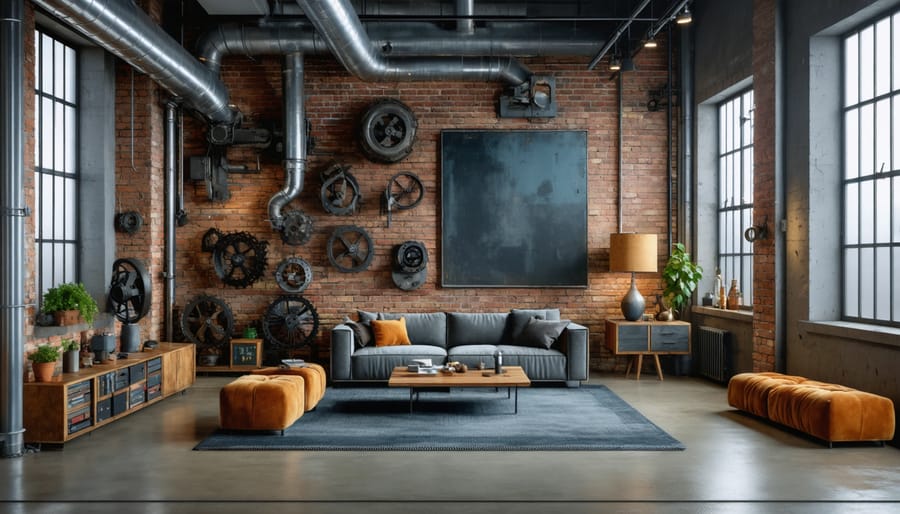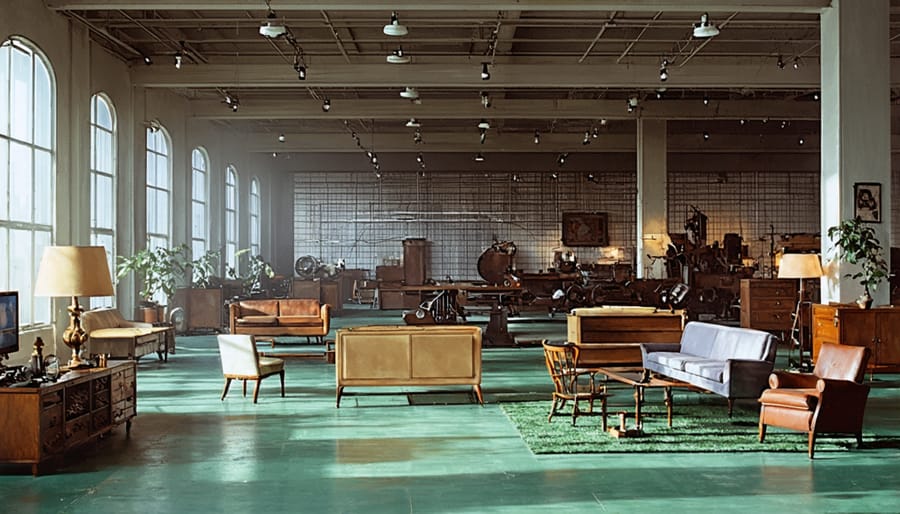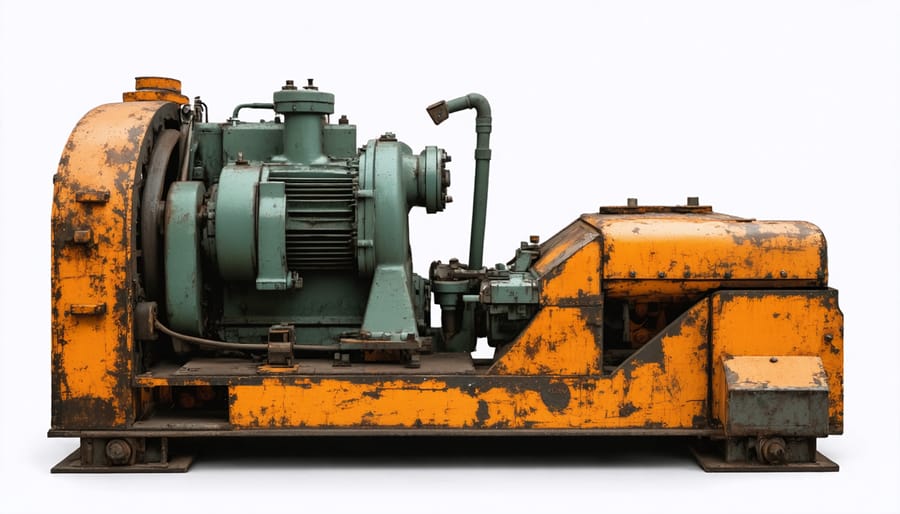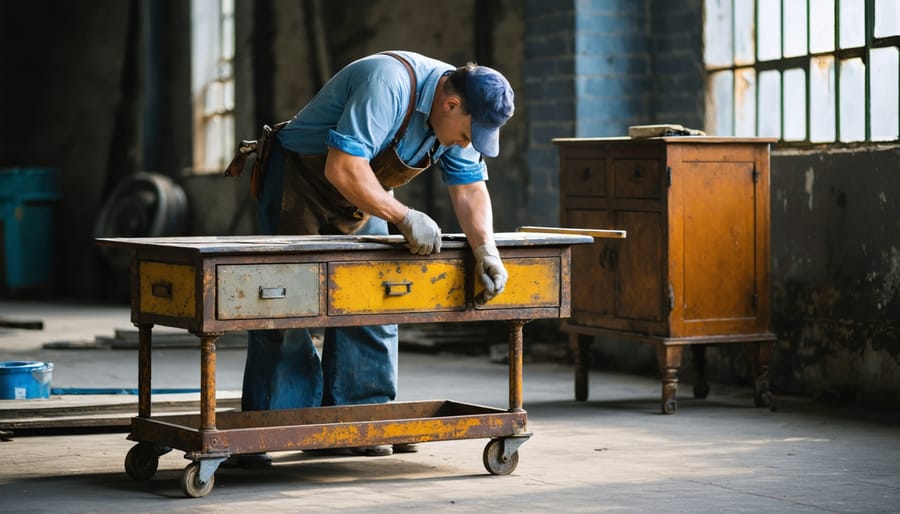
The transformation of America’s industrial landscape tells a story far more nuanced than empty factories and shuttered plants. From the bustling manufacturing hubs of the 1950s to today’s technology-driven economy, deindustrialization has fundamentally reshaped not just our economic framework, but our cultural identity and aesthetic preferences. This shift, beginning in the 1970s, sparked an unexpected renaissance in American design – particularly in furniture and interior aesthetics. As manufacturing jobs moved overseas, the industrial look paradoxically gained popularity in American homes and commercial spaces, with exposed brick, raw metals, and repurposed machinery becoming coveted design elements. This evolution from functional factory floors to sought-after style statements reflects a deeper American yearning to preserve our industrial heritage, even as our economy pivots toward services and technology. Today, the industrial aesthetic serves as both a reminder of our manufacturing past and a testament to American adaptability, where economic challenge has transformed into design opportunity.
The transformation of industrial materials into residential furniture represents a fascinating chapter in American manufacturing history. As factories began closing their doors in the 1970s and 80s, designers and homeowners discovered beauty in salvaged industrial elements. Steel workbenches became kitchen islands, factory carts transformed into coffee tables, and industrial lighting fixtures found new life in living rooms across the country.
This transition wasn’t merely aesthetic – it represented a cultural shift in how Americans viewed their industrial heritage. Materials like cast iron, steel, and reclaimed wood, once purely functional in factory settings, became prized for their authenticity and durability in home furnishings. Manufacturers began producing new pieces that mimicked this industrial look, combining modern manufacturing techniques with vintage-inspired designs.
The movement gained particular momentum in urban areas, where converted industrial lofts made industrial-style furniture feel contextually appropriate. What started as a practical way to repurpose industrial salvage evolved into a deliberate design choice that continues to influence furniture design today, reflecting both nostalgia for America’s industrial past and appreciation for authentic materials and craftsmanship.

America’s rise as an industrial powerhouse was largely fueled by its abundant natural resources and innovative manufacturing techniques. The nation’s vast forests provided high-quality hardwoods, while its rich mineral deposits supplied the raw materials needed for industrial revolution machinery. These resources enabled manufacturers to develop unique production methods that would define American manufacturing for generations.
The combination of superior materials and innovative techniques gave rise to distinctive American products. Oak, maple, and pine from American forests were transformed into durable furniture pieces, while abundant iron ore and coal powered the steel industry. American inventors developed groundbreaking manufacturing processes, including interchangeable parts and assembly line production, which revolutionized how goods were made.
This period also saw the emergence of American ingenuity in tools and machinery design. Specialized equipment for woodworking, metalworking, and textile production helped establish the United States as a global manufacturing leader. These innovations not only increased production efficiency but also created the characteristic industrial aesthetic that remains influential in modern design and restoration work.
As factories closed their doors across America, a new creative movement emerged from the industrial remnants. Designers and artisans began seeing beauty in the weathered machinery, worn metal surfaces, and aged wood that once powered the nation’s manufacturing might. This transformation gave birth to what we now recognize as industrial-style furniture, turning artifacts of America’s industrial past into sought-after design elements.
Reclaimed materials from shuttered factories became the cornerstone of this aesthetic revolution. Massive wooden beams that once supported factory floors found new life as dining room tables. Cast iron machine bases were reimagined as elegant desk supports, while factory cart wheels became striking coffee table centerpieces. Even simple elements like exposed pipes and raw metal fixtures, once purely functional, gained appreciation for their authentic character and historical significance.
This movement wasn’t just about aesthetics – it represented a sustainable approach to design that preserved pieces of American industrial heritage. Salvage yards and demolition sites became treasure troves for furniture makers, who discovered that these materials offered superior quality and durability compared to many modern alternatives. The imperfections, patina, and wear patterns that developed over decades of industrial use became highly valued characteristics, telling stories of America’s manufacturing legacy through each piece of furniture.
Today, this style continues to grow in popularity, with both major retailers and independent craftsmen incorporating industrial elements into their designs, proving that beauty can indeed rise from the ruins of deindustrialization.

The industrial aesthetic has experienced a remarkable renaissance in contemporary American design, particularly in furniture and architectural elements. As manufacturing facilities closed their doors, their distinctive features – exposed brick, steel beams, and weathered wood – became sought-after design elements in both residential and commercial spaces. This transformation reflects a fascinating paradox: as actual industry declined, the visual language of industrialization gained cultural cache.
Today’s designers skillfully blend mid-century modern design with industrial elements, creating pieces that honor America’s manufacturing heritage while meeting contemporary needs. Salvaged factory equipment finds new life as statement lighting fixtures, while reclaimed wood from defunct factories becomes premium furniture material. These design choices reflect both nostalgia for America’s industrial past and innovation in sustainable materials use.
The preservation and repurposing of industrial elements serve multiple purposes: they maintain historical connections, reduce waste through materials recycling, and create unique aesthetic appeal. This trend has spawned entire design movements, from industrial chic to steampunk, demonstrating how deindustrialization paradoxically strengthened America’s appreciation for its industrial design heritage. The movement has particularly resonated with urban professionals seeking to incorporate authentic character into their living and working spaces.

The preservation of authentic industrial furniture requires specialized techniques that honor both functionality and historical significance. Professional restorers typically begin with a thorough assessment, documenting original materials, manufacturing methods, and any unique wear patterns that tell the piece’s story.
For metal components, such as cast iron table bases or steel cabinet frames, careful rust removal is essential. Experts often use a combination of mechanical and chemical methods, starting with gentle wire brushing and progressing to specialized rust converters when necessary. Original patinas are preserved whenever possible, as they contribute to the piece’s authenticity and value.
Wood elements common in industrial furniture, like maple workbench tops or oak storage units, require different approaches. Restoration specialists focus on preserving original finishes while addressing structural issues. This might involve carefully cleaning accumulated grime, stabilizing loose joints, and applying period-appropriate finishes that protect while maintaining character.
Hardware restoration is particularly crucial for industrial pieces. Original casters, handles, and mechanical components often need cleaning, lubrication, and sometimes careful repair or reproduction using historically accurate materials and techniques. Many professionals work with specialized metalworkers to recreate missing elements when necessary.
Success in industrial furniture restoration often comes from understanding the piece’s original purpose and maintaining its functional aspects while preserving its historical integrity. The best results achieve a balance between conservation and usability, ensuring these artifacts of America’s industrial heritage continue to serve and inspire in modern settings.
For larger installations, such as factory lighting or industrial shelving systems, professionals often coordinate with structural engineers to ensure proper installation and safety compliance while maintaining authentic appearance.
While America’s manufacturing landscape has changed dramatically, contemporary artisans and furniture makers are keeping the industrial aesthetic alive through innovative approaches to design and production. These modern craftspeople draw inspiration from the raw, functional elements of America’s industrial past while incorporating sustainable materials and cutting-edge manufacturing techniques.
Today’s industrial-style furniture often features a blend of reclaimed materials from defunct factories alongside newly fabricated pieces. The Bauhaus influence on modern design remains evident in how makers emphasize the honest expression of materials and structural elements.
Small-batch manufacturing facilities and maker spaces have emerged in former industrial districts, breathing new life into abandoned warehouses and factories. These spaces serve as incubators for furniture designers who combine traditional craftsmanship with modern technology like CNC machines and 3D printing. The result is furniture that honors industrial heritage while meeting contemporary needs for sustainability and functionality.
Many manufacturers now specialize in creating authentic reproductions of classic industrial pieces, using period-correct materials and finishing techniques. Others focus on adaptive reuse, transforming salvaged industrial components into unique furniture pieces that tell a story of American manufacturing history.
This renaissance in industrial-style manufacturing has created a bridge between our manufacturing past and present, proving that while large-scale industrial production may have shifted overseas, the spirit of American industrial design continues to evolve and thrive through these innovative makers and their dedication to quality craftsmanship.
The enduring appeal of industrial furniture design stands as a testament to America’s rich manufacturing heritage, even as traditional industries have declined. Today’s homeowners and designers continue to embrace the raw authenticity of industrial elements, from exposed steel frames to reclaimed factory wood, celebrating the craftsmanship that once defined our nation’s workshops and factories.
This aesthetic serves as more than just a design trend – it’s a bridge between our manufacturing past and present. The popularity of industrial furniture in modern spaces, from urban lofts to suburban homes, reflects a collective appreciation for the quality and durability that characterized American manufacturing at its peak.
The preservation and restoration of authentic industrial pieces has become increasingly valuable, both culturally and economically. Professional restorers now play a crucial role in maintaining these tangible connections to our industrial heritage, ensuring that future generations can experience and appreciate the solid construction and timeless appeal of American-made industrial furniture.
As we continue to navigate the evolving landscape of American manufacturing, industrial furniture design remains a powerful reminder of our nation’s innovative spirit and commitment to quality craftsmanship.